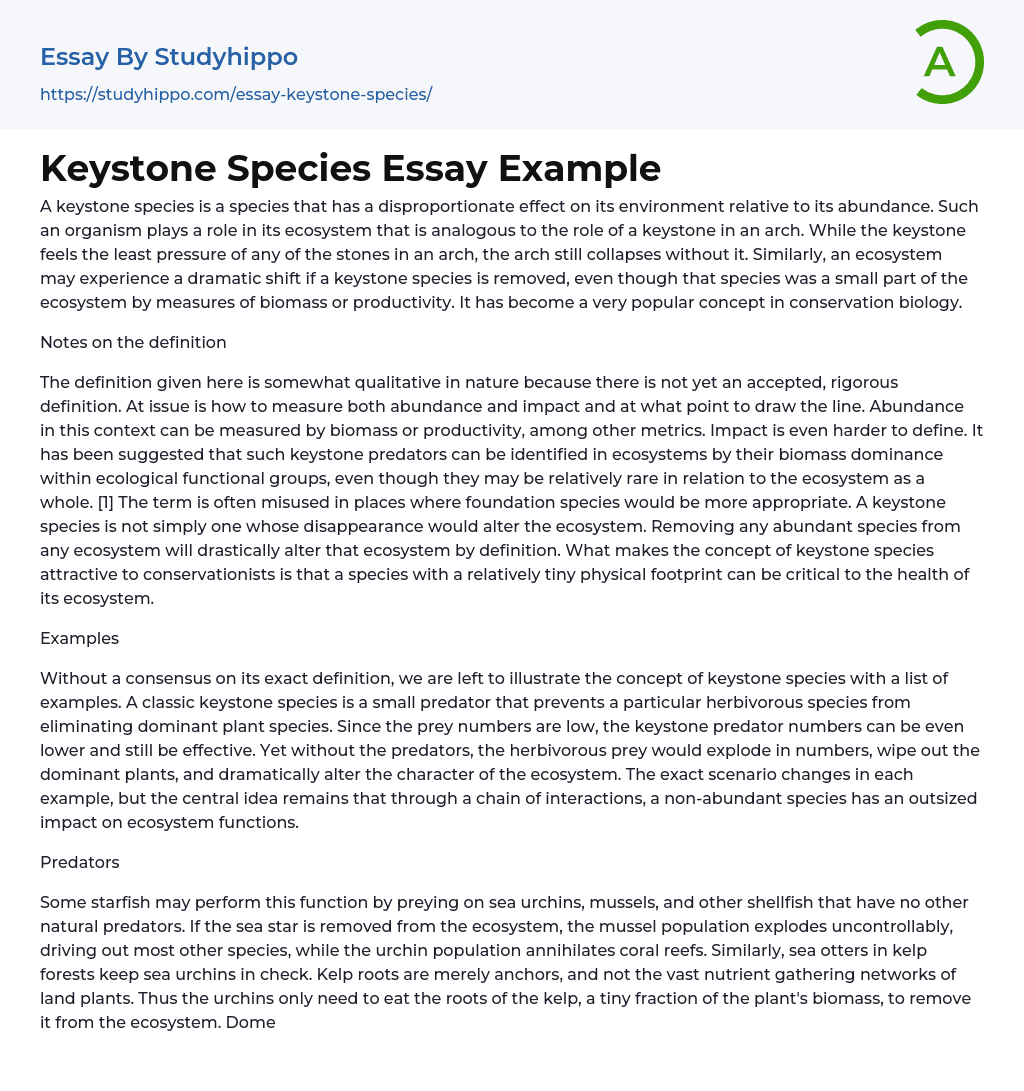A keystone species is a species that has a disproportionate effect on its environment relative to its abundance. Such an organism plays a role in its ecosystem that is analogous to the role of a keystone in an arch. While the keystone feels the least pressure of any of the stones in an arch, the arch still collapses without it. Similarly, an ecosystem may experience a dramatic shift if a keystone species is removed, even though that species was a small part of the ecosystem by measures of biomass or productivity. It has become a very popular concept in conservation biology.
Notes on the definition
The definition given here is somewhat qualitative in nature because there is not yet an accepted, rigorous definition. At issue is how to measure both abundance and impact and at what point t
...o draw the line. Abundance in this context can be measured by biomass or productivity, among other metrics. Impact is even harder to define. It has been suggested that such keystone predators can be identified in ecosystems by their biomass dominance within ecological functional groups, even though they may be relatively rare in relation to the ecosystem as a whole. [1] The term is often misused in places where foundation species would be more appropriate. A keystone species is not simply one whose disappearance would alter the ecosystem. Removing any abundant species from any ecosystem will drastically alter that ecosystem by definition. What makes the concept of keystone species attractive to conservationists is that a species with a relatively tiny physical footprint can be critical to the health of its ecosystem.
Examples
View entire sample
justify">Without a consensus on its exact definition, we are left to illustrate the concept of keystone species with a list of examples. A classic keystone species is a small predator that prevents a particular herbivorous species from eliminating dominant plant species. Since the prey numbers are low, the keystone predator numbers can be even lower and still be effective. Yet without the predators, the herbivorous prey would explode in numbers, wipe out the dominant plants, and dramatically alter the character of the ecosystem. The exact scenario changes in each example, but the central idea remains that through a chain of interactions, a non-abundant species has an outsized impact on ecosystem functions.
Predators
Some starfish may perform this function by preying on sea urchins, mussels, and other shellfish that have no other natural predators. If the sea star is removed from the ecosystem, the mussel population explodes uncontrollably, driving out most other species, while the urchin population annihilates coral reefs. Similarly, sea otters in kelp forests keep sea urchins in check. Kelp roots are merely anchors, and not the vast nutrient gathering networks of land plants. Thus the urchins only need to eat the roots of the kelp, a tiny fraction of the plant's biomass, to remove it from the ecosystem. Domestic cats have taken the role of a keystone species in many environments, including human habitations, where they control some rodent populations. Feral cats are known to decimate native populations in many places in which they are introduced. These creatures need not be apex predators. Sea stars are prey for sharks, rays, and sea anemones. Cats and sea otters are prey for raptor
birds.
Engineers
In North America, the grizzly bear is a keystone species - not as a predator but as ecosystem engineers. They transfer nutrients from the oceanic ecosystem to the forest ecosystem. The first stage of the transfer is performed by salmon who swim up rivers, sometimes for hundreds of miles. The bears then capture the salmon and carry them onto dry land, dispersing nutrient-rich feces and partially-eaten carcasses. Another ecosystem engineering keystone species is the beaver, which transforms its territory from a stream to a pond or swamp.
- Microbiology essays
- Bacteria essays
- Cell essays
- Enzyme essays
- Photosynthesis essays
- Plant essays
- Natural Selection essays
- Protein essays
- Viruses essays
- Cell Membrane essays
- Human essays
- Stem Cell essays
- Breeding essays
- Biotechnology essays
- Cystic Fibrosis essays
- Tree essays
- Seed essays
- Coronavirus essays
- Zika Virus essays
- Environmental Disaster essays
- Sustainable Development essays
- Agriculture essays
- Albert einstein essays
- Animals essays
- Archaeology essays
- Bear essays
- Biology essays
- Birds essays
- Butterfly essays
- Cat essays
- Charles Darwin essays
- Chemistry essays
- Dinosaur essays
- Discovery essays
- Dolphin essays
- Elephant essays
- Eli Whitney essays
- Environmental Science essays
- Evolution essays
- Fish essays
- Genetics essays
- Horse essays
- Human Evolution essays
- Isaac Newton essays
- Journal essays
- Linguistics essays
- Lion essays
- Logic essays
- Mars essays
- Methodology essays




